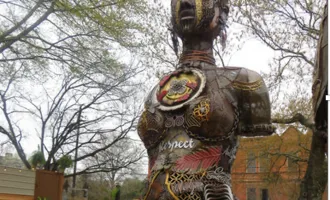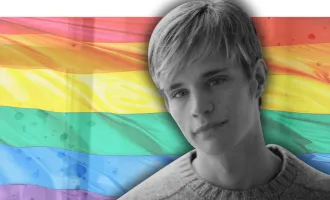
Creating a More Diverse UCSF
Minority students at UCSF face a unique set of challenges that broader diversity and stronger inclusivity would go a long way to resolving, according to a new Diversity Committee dedicated to bridging that gap.
When Jennifer Ortega recently attended the Annual Biomedical Research Conference for Minority Students, she was brought back to the excitement and insecurities of her own first research experience.
“The students are incredible,” Ortega said. “They are so eloquent. They ask such good questions. But it doesn’t feel that way when you are going through that experience. I remember it feeling very isolating. Looking at them now, I felt like I was seeing myself from the outside.”
The Neuroscience program sent Ortega, a sixth year student, to the conference as part of a new recruitment effort aiming to increase diversity in the graduate program.
As life scientists, we appreciate the value of diversity in biological systems. However, we often underestimate the role of diversity in the workplace.
Decades of research from various fields has converged on the conclusion that diversity of race, ethnicity, gender and sexual orientation improve creativity and problem solving. Putting individuals of dissimilar backgrounds together pushes group members to prepare more, anticipate differences in perspective, and ultimately leads to innovation and new ideas.
Unfortunately, human beings are limited by homophily, our tendency to form social networks with people who are similar to ourselves.
It’s difficult not to notice striking examples of this in my home program of Neuroscience. The numbers on racial representation show Neuroscience lags behind other graduate programs at UCSF. There is a single female principal investigator in the Department of Physiology. Our only black student recently graduated.
Students voiced lack of diversity as their number one concern at the first town hall meeting called by Anatol Kreitzer, the new director of the Neuroscience program. As a result, Kreitzer has made it a priority to address these issues in his first year as director.
I spoke with Kira Poskanzer, Assistant Professor and head of the Diversity Committee that Kretizer formed as part of this effort.
“Whatever endeavor you are a part of, science included, the more voices the more creatively the group can think about things because people introduce new ways of thinking that may have never occurred to you,” Poskanzer said.
She also stated personal reasons for volunteering her time to the committee.
“I have a lot of discomfort with seeing certain classes of people do certain things and not others,” she said. “I don't think there are biological reasons why that should be so. It’s structural, sociological reasons for that and it bugs me.”
When Kreitzer first announced the formation of the Diversity Committee, more scientists were interested in serving on the committee than there were spots available, suggesting this is something that many members of our neuroscience community feel strongly about. The committee now consists of student, postdoc, and faculty members to ensure that voices will be heard at each level.
The goal is also to address issues of diversity at various levels: not only to recruit more students from diverse backgrounds, but to also find ways to make the students feel supported and integrated in the community, to hire more faculty from different backgrounds, and to educate non-minority members of the program about the perspectives of minorities within it. The plan is to start participating in ongoing diversity initiatives at UCSF as well as to design some initiatives that are specific to Neuroscience.
“The anecdotal reason for lack of diversity is that we are not getting enough minority applicants,” said Poskanzer.
At the graduate student level, the Neuroscience program hopes to use the undergraduate Summer Research Training Program as one pipeline in. While other UCSF programs have taken part in the training program before, Poskanzer is now placing trainee students in neuroscience labs for the summer. In conjunction, a new mentoring program for the students introduces them to the UCSF Neuroscience community and hopefully lowers the barrier for their applying to graduate school.
Other UCSF graduate programs have also consistently been sending faculty and student ambassadors to the Society for Advancement of Chicanos/Hispanics and Native Americans in Science (SACNAS) and Annual Biomedical Research Conference for Minority Students undergraduate research conferences. UCSF Neuroscience plans to send at least two faculty and two students to each conference from now on. This is the first year the Neuroscience program has sent a representative in Ortega.
Ortega herself had participated in a summer undergraduate research program at UCSF and cited familiarity as a major reason for then applying to the graduate program. As a representative at the conference, she tried to convey to the younger students their potential for belonging at UCSF.
“Most of these students have heard of UCSF. They know that the Neuroscience program is outstanding. But they don’t necessarily know, ‘Am I going to fit into this environment?’” Ortega said.
“It’s about creating a social network that encourages students to apply to programs. They may choose to apply to a different program if they don’t see someone who is willing to be there and encourage them to apply. There’s a lot of nerves. The psychology of the student might be to think ‘maybe I would not fit into that environment, or maybe they are not looking for students like me.’ It helps so much to hear the opposite advice.”
Ortega also reported feeling conflicted about encouraging students to come to UCSF. As a cheerleader for program, she felt she was leaving out the full truth that her personal experience was that of a lot of isolation and frustration. She wanted to promote the program but at the same time wanted to make sure the students had a full sense of what it would be like to be in the program. She says that is was tough act to balance.
“I want to be truthful but I also want them to come to UCSF. I do think it is a good program and I think there need to be more minorities in science in general. But is this the best program for minority students? I don't think so. And so it’s hard.”
She expressed this sentiment in an email to the Diversity Committee upon her return, stating that the job is not over; the first step is to recruit more underrepresented minorities, but students must be provided with the right resources once they are at UCSF, since ultimately that’s what’s going to keep them around and make them successful.
Ortega said the onus of finding all the answers to inclusivity often falls on minorities unfairly. “The truth is we don't know, and frankly we are just like non-minority students in that we want to be in in lab. We want to be in a safe environment to think about science.”
Poskanzer has a few ideas. To raise awareness about specific concerns and experiences that students are having, the annual Neuroscience retreat at Asilomar now features student-led diversity related exercises that the whole community will participate it.
To keep the discussions going, the Diversity Committee is working on organizing ongoing small group lunchtime meetings between students and faculty throughout the year.
“Some people see diversity as something you have to check off as ‘Did we do enough of this?’ And it feels more like a task” Poskanzer said. “There is a population of faculty that don't give it much thought and probably won’t. This is why we are hoping some of the small group discussions with students where the topics will be student driven might let people hear a little bit more.”
Another big hurdle for minority members of the scientific community is finding mentors and role models to identify with. To address this at the level of post docs, the the Diversity Committee established an External Post Doc Seminar Series.
Four slots from the Neuroscience Formal Seminar series have been reserved for promising post docs in the Bay Area before they go on the job market, giving them practice giving talks and to interact with UCSF students and faculty.
This also gives post docs from different backgrounds more of an opportunity to feed into the faculty pipeline.
“I could see our community getting really excited about somebody and this could maybe put them at the top of some job search list in the future.”
Because faculty searches are conducted by departments and the Neuroscience program is not part of a department, it is difficult to directly influence search committees.
However, Poskanzer is hopeful to exert some influence through Neuroscience sanctioned searches, which create a faster route for newly hired faculty to join the Neuroscience program and give them access to Neuroscience graduate program students.
This is a big incentive for many candidates to come to UCSF, and allows Neuroscience to place some conditions on the searches. Rather than just posting the job search in Nature and Science, post docs in mentoring programs for minorities like Burroughs Wellcome and Broadening the Representation of Academic Investigators in NeuroScience (BRAINS) programs will be targeted.
Poskanzer spent time at the BRAINS booth at the annual Society for Neuroscience meeting in November, encouraging post docs to apply.
“I want to get UCSF’s name in the mix for people who are not hearing about UCSF or feel like UCSF might not be a friendly environment, which it might not be for now, but we would like to change that,” said Poskanzer.
The Diversity Committee is gathering data to understand how to best address questions of diversity,. While the Neuroscience program already has statistics on career trajectories of its graduates, it is not broken down by any demographics.
Poskanzer is interested in seeing graduate student outcomes along various axes.
How likely are female graduates to continue in academia? If they leave, when? What about individuals who are first in their family to go to college, or people with disabilities?
Ultimately, she wants to see where people feel less supported and where we as a program could do better. Additionally, she is gathering statistics on committee membership over the last five years.
Female faculty members have been shown to bear a larger burden of community work, which tends to be rewarded less than other kinds of work such as academic research output. Poskanzer is interested in seeing what proportion of our female faculty are serving on committees, and of those, which proportion does not lead to material rewards, such as directing National Science Foundation graduate research fellowship application workshops.
She hopes to ensure that the amount of service different faculty are doing for the program is more equitable.
On what motivates her to continue investing her time in these endeavours, “I am often very worn down by how much time it takes to be a minority in some way in science. I am spending a lot of time on this in order for other people to spend less time on it and more time on their research or other things they love.”
Ortega said she believes that lack of diversity is an institutional problem and is too much work for any one person to handle. She encourages everyone to make small efforts like attending the Annual Biomedical Research Conference for Minority Students, participating in the Science and Health Education Partnership, or teaching a lecture at SF State University.
“That in itself is a really rewarding experience, it doesn't take a lot of time, it doesn't take a lot of effort, and you might be surprised that it’s something you really enjoy,” Ortega said. That might be positive reinforcement to do more in the future, than if you say ‘Oh I just have to fix diversity in the world or in this institution.’”
“There's a lot that can be done, but it does not have to be done by one person. It can be split into a bunch of pieces.”


